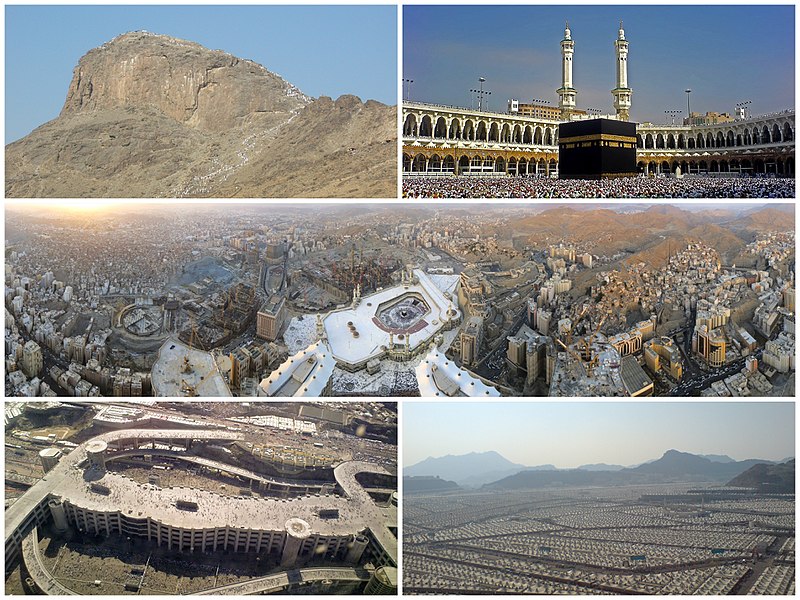
For uses see Makkah (disambiguation)
Makkah, also spelled Makkah, is a city in the Hejazi region of Saudi Arabia. 70 km (43 mi) inland from Jeddah, in a narrow valley 277 m (909 ft) above sea level, 340 kilometres (210 mi) south of Medina, its population in 2012 was 2 million, although visitors more than triple this number every year during the Ḥajj (Arabic: حَـجّ, "Pilgrimage"), held in the twelfth Muslim lunar month of Dhūl-Ḥijjah (Arabic: ذُو الْـحِـجَّـة).
As the birthplace of Muḥammad and the site of Muhammad's first revelation of the Quran, in a cave 3 km (2 mi) from Makkah, Makkah is regarded as the holiest city in Islam, and a pilgrimage to it, known as the Hajj, is obligatory for all able Muslims. Makkah is home to the Kaaba, one of Islam's holiest sites and the direction of Muslim prayer.
Makkah was long ruled by Muhammad's descendants, the sharifs, acting either as independent rulers or as vassals to larger polities. It was conquered by Ibn Saud in 1925, since when Makkah has seen a tremendous expansion in size and infrastructure, such as the Abraj Al Bait, also known as the Makkah Royal Clock Tower Hotel, the world's fourth tallest building and the building with the third largest amount of floor area, and lost some historical structures and archaeological sites, such as the Ajyad Fortress. Non-Muslims are prohibited from entering the city.
"Makkah" is the familiar form of the English transliteration for the Arabic name of the city, although the official transliteration used by the Saudi government is Makkah, which is closer to the Arabic pronunciation. The word "Makkah" in English has come to be used to refer to any place that draws large numbers of people, and because of this some English speaking Muslims have come to regard the use of this spelling for the city as offensive. The Saudi government adopted Makkah as the official spelling in the 1980s, but is not universally known or used worldwide. The full official name is Makkah al-Mukarramah (Arabic: مَـكَّـة الْـمُـكَـرَّمَـة) or Makkatu l-Mukarramah (Arabic: مَـكَّـةُ الْـمُـكَـرَّمَـة), which means "Makkah the Honored", but is also loosely translated as "The Holy City of Makkah".
The ancient or early name for the site of Makkah is Bakkah (Arabic: بَـكَّـة, also transliterated Baca, Baka, Bakah, Bakka, Becca, Bekka, etc.). An Arabic language word, its etymology, like that of Makkah, is obscure. Widely believed to be a synonym for Makkah, it is said to be more specifically the early name for the valley located therein, while Muslim scholars generally use it to refer to the sacred area of the city that immediately surrounds and includes the Ka‘bah (Arabic: كَـعْـبَـة, Kaaba). This form is used for the name Makkah in the Quran in 3:96, while the form Makkah is used in In South Arabic, the language in use in the southern portion of the Arabian Peninsula at the time of Muhammad, the b and m were interchangeable[citation needed]. Other references to Makkah in the Quran call it Umm al-Qurā (Arabic: أُمّ الْـقُـرَى), meaning "Mother of All Settlements"/"mother of villages". Another name of Makkah is Ṫihāmah (Arabic: تِـهَـامَـة).
Another name for Makkah, or the wilderness and mountains surrounding it, according to Arab and Islamic tradition, is Faran or Pharan, referring to the Desert of Paran mentioned in the Old Testament at Genesis. Arab and Islamic tradition holds that the wilderness of Paran, broadly speaking, is the Tihamah and the site where Ishmael settled was Makkah. Yaqut al-Hamawi, the 12th century Syrian geographer, wrote that Fārān was "an arabized Hebrew word, one of the names of Makkah mentioned in the Torah."
Makkah is governed by the Municipality of Makkah, a municipal council of fourteen locally elected members headed by a mayor (called Al-Amin) appointed by the Saudi government. As of May 2015, the mayor of the city was Dr. Osama bin Fadhel Al-Bar.
Makkah is the capital of the Makkah Region, which includes neighboring Jeddah. The provincial governor was prince Abdul Majeed bin Abdulaziz Al Saud from 2000 until his death in 2007. On 16 May 2007, prince Khalid bin Faisal Al Saud was appointed as the new governor.
See also Time Line Of Makkah
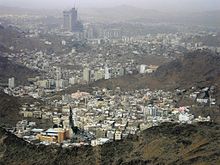
The early history of Makkah is still largely disputed, as there are no unambiguous references to it in ancient literature prior to the rise of Islam. The Roman Empire took control of part of the Hejaz in 106 CE, ruling cities such as Hegra (now known as Mada'in Saleh), located to the north of Makkah. Even though detailed descriptions were established of Western Arabia by Rome, such as by Procopius, there are no references of a pilgrimage and trading outpost such as Makkah. The first direct mention of Makkah in external literature occurs in 741 CE, in the Byzantine-Arab Chronicle, though here the author places it in Mesopotamia rather than the Hejaz.
Given the inhospitable environment and lack of historical references in Roman, Persian and Indian sources, historians including Patricia Crone and Tom Holland have cast doubt on the claim that Makkah was a major historical trading outpost.
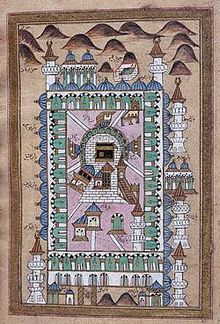
The Greek historian Diodorus Siculus writes about Arabia in his work Bibliotheca historica, describing a holy shrine: "And a temple has been set up there, which is very holy and exceedingly revered by all Arabians". Claims have been made this could be a reference to the Kaaba in Makkah. However, the geographic location Diodorus describes is located in northwest Arabia, around the area of Leuke Kome, closer to Petra and within the former Nabataean Kingdom and Rome's Arabia Petraea.
Ptolemy lists the names of 50 cities in Arabia, one going by the name of "Macoraba". There has been speculation since 1646 that this is could be a reference to Makkah, but there is no compelling explanation to link the two names.
In the Islamic view, the beginnings of Makkah are attributed to Ishmael's descendants. The Old Testament chapter Psalm 84:3–6, and a mention of a pilgrimage at the Valley of Baca, that Muslims see as referring to the mentioning of Makkah as Bakkah in Quran's Surah 3:96.[17] Some time in the 5th century, the Kaaba was a place of worship for the deities of Arabia's pagan tribes. Makkah's most important pagan deity was Hubal, which had been placed there by the ruling Quraysh tribe[41][42] and remained until the 7th century.
In the Sharḥ al- Asāṭīr, a commentary on the Samaritan midrashic chronology of the Patriarchs, of unknown date but probably composed in the tenth century C.E., it is claimed that Makkah was built by the sons of Nebaioth, the eldest son of Ishmael.[43][44][45]
In the 5th century, the Quraysh took control of Makkah, and became skilled merchants and traders. In the 6th century they joined the lucrative spice trade, since battles elsewhere were diverting trade routes from dangerous sea routes to more secure overland routes. The Byzantine Empire had previously controlled the Red Sea, but piracy had been increasing. Another previous route that ran through the Persian Gulf via the Tigris and Euphrates rivers was also being threatened by exploitations from the Sassanid Empire, and was being disrupted by the Lakhmids, the Ghassanids, and the Roman–Persian Wars. Makkah's prominence as a trading center also surpassed the cities of Petra and Palmyra.[46][47] The Sassanids however did not always pose a threat to Makkah, as in 575 CE they protected Makkah city from invasion by the Kingdom of Axum, led by its Christian leader Abraha. The tribes of southern Arabia asked the Persian king Khosrau I for aid, in response to which he came south to Arabia with foot-soldiers and a fleet of ships into Makkah. The Persian intervention prevented Christianity from spreading eastward into Arabia, and Makkah and the Islamic prophet Muhammad, who was at the time six years old in the Quraysh tribe, "would not grow up under the cross."[48]
By the middle of the 6th century, there were three major settlements in northern Arabia, all along the south-western coast that borders the Red Sea, in a habitable region between the sea and the great mountains to the east. Although the area around Makkah was completely barren, it was the wealthiest of the three settlements with abundant water via the renowned Zamzam Well and a position at the crossroads of major caravan routes.[49]
The harsh conditions and terrain of the Arabian peninsula meant a near-constant state of conflict between the local tribes, but once a year they would declare a truce and converge upon Makkah in an annual pilgrimage. Up to the 7th century, this journey was intended for religious reasons by the pagan Arabs to pay homage to their shrine, and to drink from the Zamzam Well. However, it was also the time each year that disputes would be arbitrated, debts would be resolved, and trading would occur at Makkan fairs. These annual events gave the tribes a sense of common identity and made Makkah an important focus for the peninsula.[50]
The Year of the Elephant is the name in Islamic history for the year approximately equating to 570 CE. According to Islamic tradition, it was in this year that Muhammad was born.[51] The name is derived from an event said to have occurred at Makkah. According to early Islamic historians such as Ibn Ishaq, Abraha, the Christian ruler of Yemen, which was subject to the Kingdom of Aksum of Ethiopia, built a great church at Sana'a known as al-Qullays in honor of the Aksumite king Negus. It gained widespread fame, even gaining the notice of the Byzantine Empire.[51] Abraha attempted to divert the pilgrimage of Arab people from Kaaba to al-Qullays and appointed a man named Muhammad ibn Khuza'i to Makkah and Tihamah as a king with a message that al-Qullays was both much better than other houses of worship and purer, having not been defiled by the housing of idols.[51] When Muhammad ibn Khuza'i got as far as the land of Kinana, the people of the lowland, knowing what he had come for, sent a man of Hudhayl called ʿUrwa bin Hayyad al-Milasi, who shot him with an arrow, killing him. His brother Qays who was with him fled to Abraha and told him the news, which increased his rage and fury and he swore to raid the Kinana tribe and destroy the temple. Ibn Ishaq further states that one of the men of the Quraysh tribe was angered by this, and going to Sana'a, slipped into the church at night and defiled it; it is widely assumed that they did so by defecating in it. Abraha[52][53] marched upon the Kaaba with a large army, which included one or more war elephants, intending to demolish it. When news of the advance of Abraha's army came, the Arab tribes of the Quraysh, Banu Kinanah, Banu Khuza'a and Banu Hudhayl united in defense of the Kaaba. A man from the Himyarite Kingdom was sent by Abraha to advise them that Abraha only wished to demolish the Kaaba and if they resisted, they would be crushed. Abdul Muttalib told the Meccans to seek refuge in the hills while he with some leading members of the Quraysh remained within the precincts of the Kaaba. Abraha sent a dispatch inviting Abdul-Muttalib to meet with Abraha and discuss matters. When Abdul-Muttalib left the meeting he was heard saying, "The Owner of this House is its Defender, and I am sure he will save it from the attack of the adversaries and will not dishonor the servants of His House." Abraha attacked Mecca. However, the lead elephant, known as Mahmud,[54] is said to have stopped at the boundary around Makkah and refused to enter. It has been theorized that an epidemic such as by smallpox could have caused such a failed invasion of Makkah.[55] The reference to the story in Qur'an is rather short. According to the Surah of Al-Fil, the next day, [as Abraha prepared to enter the city], a dark cloud of small birds sent by Allah appeared. The birds carried small rocks in their beaks, and bombarded the Ethiopian forces and smashed them like "eaten straw".[56]
Camel caravans, said to have first been used by Muhammad's great-grandfather, were a major part of Makkah's bustling economy. Alliances were struck between the merchants in Makkah and the local nomadic tribes, who would bring goods – leather, livestock, and metals mined in the local mountains – to Makkah to be loaded on the caravans and carried to cities in Shaam and Iraq.[57] Historical accounts also provide some indication that goods from other continents may also have flowed through Makkah. Goods from Africa and the Far East passed through en route to Syria including spices, leather, medicine, cloth, and slaves; in return Makkah received money, weapons, cereals and wine, which in turn were distributed throughout Arabia. The Makkans signed treaties with both the Byzantines and the Bedouins, and negotiated safe passages for caravans, giving them water and pasture rights. Makkah became the center of a loose confederation of client tribes, which included those of the Banu Tamim. Other regional powers such as the Abyssinian, Ghassan, and Lakhm were in decline leaving Makkan trade to be the primary binding force in Arabia in the late 6th century.[50]
Some Thamudic inscriptions which were discovered in the south Jordan contained names of some individuals such as ‘Abd Mekkat (Arabic: عَـبْـد مَـكَّـة, "Servant of Makkah").[58]
There were also some other inscriptions which contained personal names such as Makky (Arabic: مَـكِّي, "Makkan"), but Jawwad Ali from the University of Baghdad suggested that there's also a probability of a tribe named "Makkah".[59]
According to Islamic tradition, the history of Makkah goes back to Abraham (Ibrahim), who built the Kaaba with the help of his elder son Ishmael in around 2000 BCE, when the inhabitants of the site then known as Bakkah had fallen away from the original monotheism of Abraham through the influence of the Amalekites.
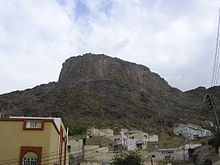
Muhammad was born in Makkah in 570, and thus Islam has been inextricably linked with it ever since. He was born in a minor faction, the Hashemites, of the ruling Quraysh tribe. It was in Makkah, in the nearby mountain cave of Hira on Jabal al-Nour, that, according to Islamic tradition, Muhammad began receiving divine revelations from God through the Archangel Gabriel in 610 AD, and advocated his form of Abrahamic monotheism against Makkan paganism. After enduring persecution from the pagan tribes for 13 years, Muhammad emigrated (see Hijrah) in 622 with his companions, the Muhajirun, to Yathrib (later called Medina). The conflict between the Quraysh and the Muslims, however, continued: The two fought in the Battle of Badr, where the Muslims defeated the Quraysh outside Medina; while the Battle of Uhud ended indecisively. Overall, Makkan efforts to annihilate Islam failed and proved to be costly and unsuccessful. During the Battle of the Trench in 627, the combined armies of Arabia were unable to defeat Muhammad's forces.
In 628, Muhammad and his followers wanted to enter Makkah for pilgrimage, but were blocked by the Quraysh. Subsequently, Muslims and Makkans entered into the Treaty of Hudaybiyyah, whereby the Quraysh promised to cease fighting Muslims and promised that Muslims would be allowed into the city to perform the pilgrimage the following year. It was meant to be a ceasefire for 10 years. However, just two years later, the Quraysh violated the truce by slaughtering a group of Muslims and their allies. Muhammad and his companions, now 10,000 strong, marched into Makkah. However, instead of continuing their fight, the city of Makkah surrendered to Muhammad, who declared peace and amnesty for its inhabitants. The pagan imagery was destroyed by Muhammad's followers and the location Islamized and rededicated to the worship of God. Makkah was declared as the holiest site in Islam ordaining it as the center of Muslim pilgrimage, one of the faith's Five Pillars. Then, Muhammad returned to Medina, after assigning Akib ibn Usaid as governor of the city. His other activities in Arabia led to the unification of the peninsula.
Muhammad died in 632, but with the sense of unity that he had passed on to his Ummah (Islamic nation), Islam began a rapid expansion, and within the next few hundred years stretched from North Africa into Asia and parts of Europe. As the Islamic Empire grew, Makkah continued to attract pilgrims from all across the Muslim world and beyond, as Muslims came to perform the annual Hajj pilgrimage.
Makkah also attracted a year-round population of scholars, pious Muslims who wished to live close to the Kaaba, and local inhabitants who served the pilgrims. Due to the difficulty and expense of the Hajj, pilgrims arrived by boat at Jeddah, and came overland, or joined the annual caravans from Syria or Iraq.
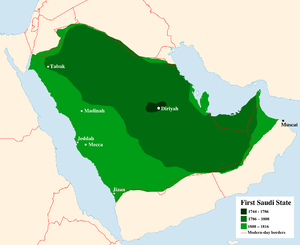
Makkah was never the capital of any of the Islamic states but Muslim rulers did contribute to its upkeep. During the reigns of Umar (634–644 CE) and Uthman ibn Affan (644–656) concerns of flooding caused the caliphs to bring in Christian engineers to build barrages in the low-lying quarters and construct dykes and embankments to protect the area round the Kaaba.
Muhammad's migration to Medina shifted the focus away from makkah. This focus moved still more when Ali, the fourth caliph, took power choosing Kufa as his capital. The Umayyad Caliphate moved the capital to Damascus in Syria and the Abbasid Caliphate to Baghdad, in modern-day Iraq, which remained the center of the Islamic Empire for nearly 500 years. Makkah re-entered Islamic political history during the Second Islamic Civil War, when it was held by Abd Allah ibn al-Zubayr, an early Muslim who opposed the Umayyad caliphs. The city was twice besieged by the Umayyads, in 683 and 692. For some time thereafter the city figured little in politics, remaining a city of devotion and scholarship governed by the Hashemite Sharifs.
In 930, Makkah was attacked and sacked by Qarmatians, a millenarian Ismaili Muslim sect led by Abū-Tāhir Al-Jannābī and centered in eastern Arabia.[62] The Black Death pandemic hit Makkah in 1349.
In 1517, the Sharif, Barakat bin Muhammed, acknowledged the supremacy of the Ottoman Caliph but retained a great degree of local autonomy.
In 1803 the city was captured by the First Saudi State,[65] which held Makkah until 1813. This was a massive blow to the prestige of the (Turkish) Ottoman Empire, which had exercised sovereignty over the holy city since 1517. The Ottomans assigned the task of bringing Makkah back under Ottoman control to their powerful Khedive (viceroy) of Egypt, Muhammad Ali Pasha. Muhammad Ali Pasha successfully returned Makkah to Ottoman control in 1813.
In 1818, followers of the Salafi juristic school were again defeated, but some of the Al Saud clan survived and founded the Second Saudi State that lasted until 1891 and led on to the present country of Saudi Arabia.
makkah was regularly hit by cholera outbreaks. Between 1830 and 1930 cholera broke out among pilgrims at Makkah 27 times.